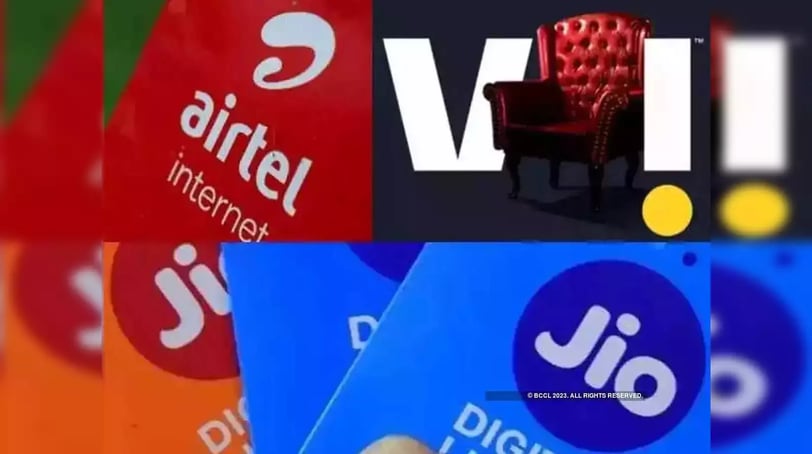Add your promotional text...
Indian Telecom: The Road Ahead for Vodafone Idea, Bharti Airtel, and Jio
Synopsis: The Indian telecom sector is at a pivotal juncture, with Bharti Airtel and Jio poised for long-term growth driven by tariff hikes and capex normalization. Meanwhile, Vodafone Idea’s sustainability hinges on multiple challenges, including steep tariff increases and favorable government support. In this blog, we explore JM Financial’s outlook, stock ratings, and price targets for key telecom players.
TRENDING STOCKS
By Aman Jaiswal
12/2/20243 min read


A Sector Under Transition
India’s telecom sector is experiencing significant shifts, with market leaders like Bharti Airtel and Jio consolidating their positions and Vodafone Idea (VIL) grappling with sustainability challenges. JM Financial’s recent analysis offers valuable insights into the sector's trajectory and the performance of its major players.
Vodafone Idea: A Steep Hill to Climb
Shares of Vodafone Idea (VIL) have been under pressure, with JM Financial maintaining a “Sell” rating and a target price of ₹10. Here’s why:
Tariff Hikes Essential:
VIL’s Average Revenue Per User (ARPU) needs to increase from ₹156 in Q2 FY24 to ₹380 by FY27 to meet its annual payment obligations of ₹43,000 crore for FY27-31.
Without significant tariff hikes, the company could face a ₹40,000 crore shortfall by FY27.
Government Support Critical:
The recently concluded ₹24,000 crore equity fundraise ensures medium-term survival, but long-term viability depends on government intervention.
Options include equity conversion of dues or extending moratorium periods, though a debt waiver is ruled out under the Telecommunications Act 2023.
Capex Challenges:
To remain competitive, VIL must boost annual capex to ₹10,000-15,000 crore (15-20% of revenue), matching industry leaders Bharti Airtel and Jio.
Ownership Dilution Risk:
Failure to meet obligations could lead to GoI converting dues into equity, diluting VIL’s minority stake from 39.5% to 28.6%.
In a bull-case scenario, JM Financial estimates VIL’s fair value could rise to ₹15/share, but risks remain high.
Bharti Airtel: Positioned for Growth
JM Financial remains bullish on Bharti Airtel, reiterating a “Buy” rating with:
One-year Target Price: ₹1,850
Three-year Target Price: ₹2,400
Key Drivers:
ARPU Growth:
Airtel’s ARPU is expected to grow at an 11% CAGR, reaching ₹310 by FY28, driven by frequent tariff hikes in a consolidated industry.
Airtel’s premium subscriber base positions it as the biggest beneficiary of higher tariffs.
Earnings and Cash Flow:
Consolidated Ebitda is projected to grow at a 13% CAGR over FY24-28.
FCF generation from FY25 onwards will enable Bharti Airtel to achieve a net cash position by FY29, enhancing equity value.
Capex Normalization:
Stabilized capex spending will further strengthen Airtel’s financial health, aiding its long-term growth trajectory.
Jio: Steady Growth Prospects
Reliance Jio Infocomm, though unlisted, continues to command a positive outlook from JM Financial. Key points include:
Sustained Free Cash Flow (FCF) growth driven by tariff hikes.
Capitalizing on its significant 5G investments and potential IPO plans, which could unlock value.
Bharti Hexacom and Indus Towers
Bharti Hexacom:
Maintains a “Buy” rating with:
One-year Target Price: ₹1,445
Three-year Target Price: ₹1,980
Positioned as a midcap pure-play on wireless ARPU growth, Hexacom offers a 15% IRR potential over three years.
Indus Towers:
Rated as “Hold” with a target price of ₹350.
The outlook is tempered by VIL’s precarious financial health, which poses risks to Indus Towers’ long-term survivability.
The Big Picture: Telecom Sector Outlook
Winners:
Bharti Airtel and Jio are well-placed to thrive, supported by frequent tariff hikes, capex normalization, and robust FCF growth.
These factors could position both players as net cash positive by FY29-30, bolstering their financial stability and market leadership.
Struggles:
Vodafone Idea’s survival hinges on steep tariff hikes, government intervention, and aggressive capex investments. Without these, the company risks dilution of ownership and potential marginalization.
A Tale of Contrasts
The Indian telecom sector presents a stark contrast: while Bharti Airtel and Jio continue to capitalize on industry consolidation, Vodafone Idea faces an uphill battle for sustainability. Investors are advised to tread cautiously, keeping an eye on tariff trends, capex plans, and policy developments.
Disclaimer:
This article is intended for informational purposes only and does not constitute investment advice. Consult a financial advisor before making investment decisions.
